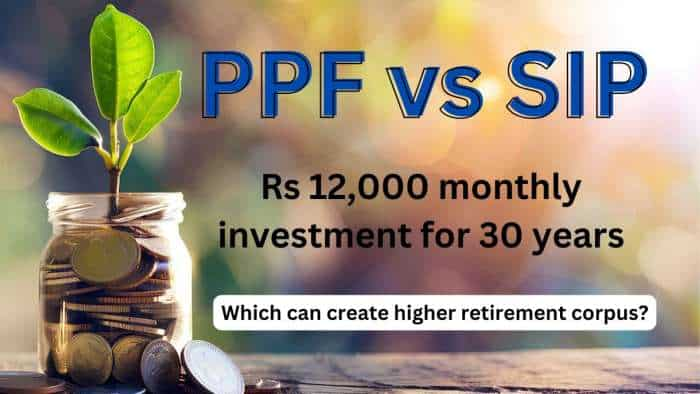NPS vs SIP: Did you start saving late? Check which is better investment plan
National Pension Scheme (NPS) and Systematic Investment Plan (SIP) are two lucrative options if you started saving late for retirement. Here are their income tax beneifts and returns compared.

This famous Mark Twain quote has nothing do with investments, "Never put off till tomorrow what may be done day after tomorrow just as well." But, it does tell you how guilty we all are of procrastinating all the time when it comes to making money investment decisions. According to a report published by HSBC in September 2018, only one third Indians save regularly for their retirement while just 33 per cent of working-age respondents globally are putting anything aside for their later life. The report said that this was largely due to lack of knowledge on how much money is needed in retirement. Yes, retirement planning is the farthest thing on our minds till virtually the fact of not having enough money deals you a tight slap in the face. By then it is very, very late, but solutions are available even then for you to make amends.
The same report said that about 53% people save for short-term goals rather than longer term plans. But, it is important to understand that even if you have delayed retirement planning, there is no need to worry. You can start saving for retirement even at a later stage. For this, National Pension Scheme (NPS) and Systematic Investment Plan (SIP) are two lucrative options. Both schemes come with different benefits and risk factors.
What is National Pension Scheme or NPS?
An initiative of the Central government, NPS is open to employees from public, private and even the unorganized sectors with the exception of those from the armed forces. The scheme encourages people to invest in a pension account at regular intervals. They can take out a specific amount after retirement. The rest of the amount is given as monthly pensions post retirement.
Watch this Zee Business video -
5 साल के लिए चुनिए शानदार शेयर, जो कराएंगे आपका मुनाफा..जानने के लिए देखिए 'चुनाव के सही उम्मीदवार' https://t.co/ncmkGRAgzl
— Zee Business (@ZeeBusiness) March 15, 2019
What is Systematic Investment Plan or SIP?
Systematic Investment Plan or SIP allows you to invest in mutual fund schemes on a regular basis. In this investment scheme, a fixed amount is deducted from your savings account every month and is invested in the mutual fund you choose to invest in. The scheme promises higher returns in shorter period.
Which is better investment option?
Archit Gupta, Founder & CEO ClearTax believes that you should allow your investment goals and risk tolerance to direct you as to where to park your money and exactly how much. However, both the schemes come with different benefits and a comparison would allow you to make a better decision.
Income Tax benefits for you
Both the NPS and SIP options qualify for income tax benefits. But, you will have to invest in ELSS or tax saving mutual fund instead of a regular scheme to avail benefits. "Investing in a tax-saving mutual fund (ELSS) through SIPs qualifies for tax deduction under 80C. For instance, if you invest Rs 12,500 monthly it amounts to Rs 1.5 lakhs per annum," Gupta said.
He added that NPS is a better option if an investor is looking for a government-backed scheme. "Aside from the 80C deduction of up to Rs.1.5 lakhs from your annual taxable income, you can also claim an additional deduction of Rs 50,000 under 80CCD(1B)," he said.
NPS vs SIP: Risk and returns
Since both invest in equities, the risk is on the higher side. Gupta explained that in NPS, a maximum of 75% of your investments can go to equities and the remaining gets invested in debt based products. But, in ELSS, you can get up to 100% equity exposure. He said that both options are actively managed and the market volatility impacts both.
However, SIPs are expected to give you better returns in most cases. "If you invest in ELSS through SIPs, you may accumulate higher corpus for post-retirement years by earning relatively higher returns," he said.
Watch this Zee Business video -
#AajKe2000 | आज का वो कौन सा शेयर है जो कराएगा आपकी तगड़ी कमाई? जानिए मुनाफे वाला शेयर अनिल सिंघवी से।@AnilSinghviZEE pic.twitter.com/QZCsRtvTt7
— Zee Business (@ZeeBusiness) March 15, 2019
NPS vs SIP: Lock-in period
Gupta explained that you can withdraw the NPS corpus only after 60 while the lock-in period for ELSS is 3 years. "So, if you are saving towards a specific event in 3-5 years, and you still have a long investment horizon ahead of you, you may consider ELSS. If retirement planning is the priority, NPS can be one option," he said.
Income Tax at withdrawal
This is probably the most important yet often ignored part of any investment. Even if you end up getting decent returns, there are chances that you may have to pay a large part of that as taxes. In case of NPS, out of the 60 per cent amount that is withdrawn at the time of retirement, 40% is tax exempt and 20% is taxable.
"On retirement, you can withdraw only 60% of the corpus in NPS. This 60% which is can be withdrawn at the time of retirement, 40% is tax exempt and 20% is taxable. Remaining 40% of the total accumulated NPS corpus is exempt if utilized for the purchase of the annuity," Gupta said.
The amount invested through SIPs, on the other hand, is eligible for long-term capital gains tax if the returns are more than Rs 1 lakh. "In ELSS, there is no such restriction and you can withdraw the entire corpus on maturity. However, if your returns exceed Rs. 1 lakh, then a 10% LTCG or long-term capital gains tax applies," he said.
Get Latest Business News, Stock Market Updates and Videos; Check your tax outgo through Income Tax Calculator and save money through our Personal Finance coverage. Check Business Breaking News Live on Zee Business Twitter and Facebook. Subscribe on YouTube.
RECOMMENDED STORIES

Power of Rs 15,000 SIP: How long it will take to achieve Rs 7 crore corpus? See calculations to know

PPF vs SIP: Rs 12,000 monthly investment for 30 years; see which can create higher retirement corpus

SIP in Stocks For New Year 2025: Market guru Anil Singhvi recommends 1 largecap, 2 midcap scrips to buy in dips; note down targets

Largecap, Midcap Stocks To Buy: Analysts recommend buying L&T, Tata Motors, 3 other stocks for 2 weeks; check targets
11:59 AM IST









 PPF vs SIP: Rs 12,000 monthly investment for 30 years; see which can create higher retirement corpus
PPF vs SIP: Rs 12,000 monthly investment for 30 years; see which can create higher retirement corpus Top 5 SIP mistakes one must avoid while investing in 2025
Top 5 SIP mistakes one must avoid while investing in 2025 Net inflows in SIPs up 233% in India this year, mutual fund industry sees 135% growth
Net inflows in SIPs up 233% in India this year, mutual fund industry sees 135% growth Retirement Planning: SWP vs dividend plan, which one is better for regular income for retirees and why? Know from experts
Retirement Planning: SWP vs dividend plan, which one is better for regular income for retirees and why? Know from experts Maximise Your Investment Using Step-up SIP: Raising Rs 5,000/month contribution by 10% annually can make a huge difference; see example
Maximise Your Investment Using Step-up SIP: Raising Rs 5,000/month contribution by 10% annually can make a huge difference; see example